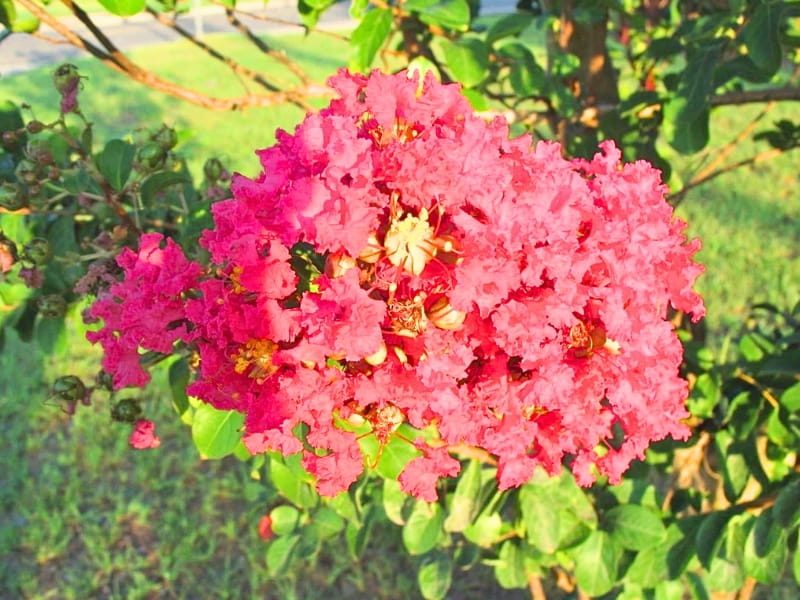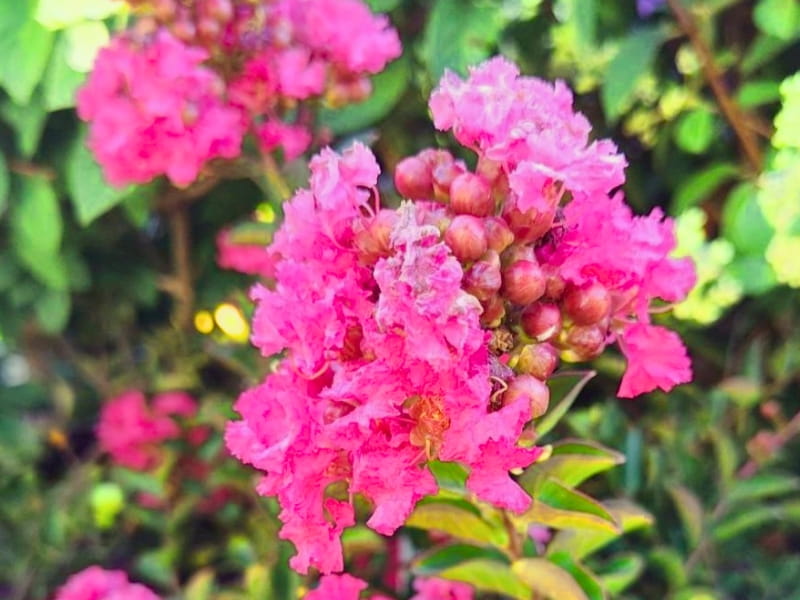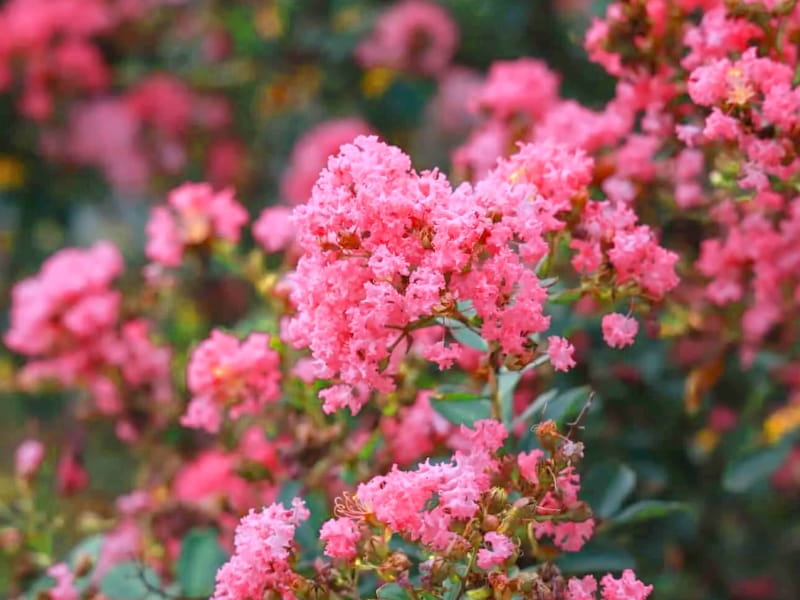The Pink Velour Crape Myrtle, also known by other common names like Pink Velour Crape Flower, or simply, crepe myrtle, and botanically as Lagerstroemia indica ‘Pink Velour’, is a stunning deciduous tree adored for its vibrant, long-lasting blooms, smooth, exfoliating bark, and attractive fall foliage.
This guide is designed to fully address your landscaping vision. We’ll walk you through every step, from initial selection and planting to ongoing care and even troubleshooting common problems. Continue reading to discover the wealth of information we’ve compiled to help you successfully cultivate and enjoy this exceptional pink crape myrtle variety.

Understanding the Pink Velour Crape Myrtle: A Deep Dive
The Pink Velour Crape Myrtle stands out in the Lagerstroemia genus for several reasons. It’s not just another pretty face in the landscape; it’s a carefully bred cultivar with specific characteristics that make it a favorite among gardeners and landscapers. To truly appreciate this tree, it’s vital to understand its origins, growth habits, and unique attributes.
| Common name | Pink Velour Crape Myrtle, Pink Velour Crape Flower, Crepe Myrtle |
| Botanical name | Lagerstroemia indica ‘Pink Velour’ |
| Family | Lythraceae |
| Genus | Lagerstroemia |
| Species | indica |
| Origin | Hybrid (Developed in the United States) |
| Native | Not native to any one specific area, widely adapted |
| Life cycle | Perennial (Deciduous) |
| Plant type | Tree/Shrub |
| Hardiness zone | 7-9 |
| Sunlight | Full Sun (6-8 hours minimum) |
| Maintenance | Low to Moderate |
| Water | Moderate (Drought-tolerant once established) |
| Drainage | Well-Drained |
| Spacing | 8-12 ft. |
| Flowering period | Early Summer to Fall (Long Blooming Season) |
| Height | 10-15 ft. |
| Spread | 8-12 ft. |
| Growth rate | Moderate (1-2 ft. per year) |
| Flower color | Deep, Velvety Pink |
| Leaf color (Growing Season) | Dark Green |
| Fall color | Orange, Red, Yellow |
| Bark | Exfoliating (Cinnamon Brown, Gray, Cream) |
| Flower benefit | Showy, Long Bloom Season, Attracts Pollinators |
| Garden style | Versatile (Specimen, Foundation, Street, Patio, Screening) |
| Uses | Ornamental, Shade, Privacy, Wildlife Attraction |
| Soil pH | Slightly Acidic to Neutral (6.0-7.0) |
| Disease Resistance | High (Especially to Powdery Mildew) |
| Pest Resistance | Generally good, but monitor for aphids, Japanese beetles, scale |
| Deer Resistance | Moderately Resistant |
| Drought Tolerance | High (Once Established) |
| Salt Tolerance | Moderate |
- Origins and Breeding: ‘Pink Velour’ is a result of deliberate hybridization, aiming to combine the best traits of various crape myrtle species. The goal was to create a variety with intense flower color, improved disease resistance, particularly to powdery mildew (a common ailment of older crape myrtle varieties), and a desirable growth habit. It emerged as a standout selection, quickly gaining popularity after its introduction.
- Distinctive Features:
- Vibrant Pink Blooms: The defining characteristic is, of course, the intense, velvety pink flowers. These aren’t just any pink; they’re a rich, saturated hue that holds its color well throughout the blooming season, which typically extends from early summer to fall, providing months of visual appeal. The flower clusters, or panicles, are large and dense, creating a spectacular display.
- Exfoliating Bark: As the tree matures, the bark begins to peel away in layers, revealing a smooth, mottled surface underneath. This adds year-round interest, even when the tree is not in bloom. The colors range from cinnamon brown to gray and cream, creating a beautiful mosaic effect.
- Compact Size: Pink Velour is considered a medium-sized crape myrtle. It typically reaches a height of 10-15 feet and a spread of 8-12 feet. This makes it suitable for a variety of landscape applications, including smaller gardens, foundation plantings, and even large containers.
- Fall Foliage: Before dropping its leaves in the autumn, the Pink Velour Crape Myrtle puts on another show. The foliage turns vibrant shades of orange, red, and yellow, adding another layer of seasonal interest.
- Disease Resistance: As mentioned, this cultivar was specifically bred for improved resistance to powdery mildew. While no plant is entirely immune, Pink Velour demonstrates significantly better resistance than many older varieties.
- Growth Rate and Habit: Pink Velour has a moderate growth rate, typically adding 1-2 feet per year under optimal conditions. It tends to have an upright, vase-shaped growth habit, becoming more rounded with age. This makes it easy to manage and shape through pruning.
- Sunlight and Soil Requirements: This tree thrives in full sun, requiring at least 6-8 hours of direct sunlight per day for optimal flowering and growth. It prefers well-drained soil that is slightly acidic to neutral (pH 6.0-7.0). While it can tolerate a range of soil types, it performs best in fertile, loamy soil.
- Hardiness Zones: Pink Velour is generally hardy in USDA zones 7-9. This means it can tolerate winter temperatures down to about 0°F (-18°C). In colder zones, it may be grown as a container plant and brought indoors during the winter.
Comparison to Other Crape Myrtle Varieties: The following table shows comparisons.
| Feature | Pink Velour | Natchez Crape Myrtle | Tuscarora Crape Myrtle |
| Flower Color | Deep Pink | White | Coral Pink |
| Mature Height | 10-15 ft | 20-30 ft | 15-20 ft |
| Powdery Mildew Resistance | High | High | High |
| Bark Exfoliation | Excellent | Excellent | Good |
| Fall Color | Orange, Red, Yellow | Orange, Red | Red, Orange |

Planting Your Pink Velour Crape Myrtle: A Step-by-Step Guide
Planting a Pink Velour Crape Myrtle correctly is crucial for its long-term health and vibrant display. Gardencenterpoint.com is providing a detailed, step-by-step guide to ensure your tree gets the best possible start.
- 1. Choosing the Right Location:
- Sunlight: As mentioned, full sun (6-8 hours of direct sunlight daily) is essential. Observe the potential planting site throughout the day to ensure it receives adequate sunlight.
- Space: Consider the mature size of the tree (10-15 feet tall and 8-12 feet wide). Allow enough space for it to grow without crowding other plants or structures.
- Soil Drainage: Avoid areas with standing water or poor drainage. Crape myrtles are susceptible to root rot in soggy conditions. A simple drainage test involves digging a hole 12 inches deep and filling it with water. If the water drains within a few hours, the drainage is adequate.
- Air Circulation: Good air circulation helps prevent fungal diseases. Avoid planting in overly sheltered locations.
- 2. Timing the Planting:
- The best time to plant a crape myrtle is in the fall or early spring, while the tree is dormant. This allows the roots to establish before the stress of summer heat. In milder climates, fall planting is often preferred, as it gives the roots a longer period to establish before the growing season.
- 3. Preparing the Planting Hole:
- Dig a hole that is twice as wide as the root ball and just as deep. This provides ample space for the roots to spread.
- Loosen the soil at the bottom and sides of the hole with a garden fork. This improves drainage and encourages root growth.
- Do not amend the soil in the planting hole unless it is extremely poor (e.g., heavy clay or compacted soil). In such cases, amend sparingly with compost or other organic matter. Adding too much amendment can create a “bathtub effect,” where water collects in the planting hole and drowns the roots.
- 4. Removing the Tree from the Container:
- Carefully slide the tree out of its container. If it’s stuck, gently tap the sides of the container to loosen the root ball.
- Inspect the roots. If they are circling the root ball, gently tease them apart with your fingers or a sharp knife. This encourages outward growth rather than continued circling.
- 5. Planting the Tree:
- Place the tree in the center of the hole. The top of the root ball should be level with or slightly above the surrounding ground. Planting too deep can lead to root rot.
- Backfill the hole with the native soil, gently firming it around the roots to eliminate air pockets.
- Water thoroughly after planting to settle the soil.
- 6. Mulching:
- Apply a 2-3 inch layer of organic mulch (such as shredded bark, pine straw, or compost) around the base of the tree, keeping it a few inches away from the trunk. Mulch helps retain moisture, suppress weeds, and regulate soil temperature.
- 7. Watering:
- Water deeply and regularly during the first growing season, especially during dry periods. The goal is to keep the soil consistently moist, but not soggy.
- Once established, crape myrtles are relatively drought-tolerant, but they will still benefit from occasional watering during prolonged dry spells.
- 8. Staking (If Necessary):
- Young trees may benefit from staking, especially in windy locations. Use two or three stakes placed outside the root ball and secure the tree with flexible ties. Remove the stakes after one growing season.
Caring for Your Pink Velour Crape Myrtle: Ongoing Maintenance
Once your Pink Velour Crape Myrtle is established, ongoing care is relatively straightforward. However, consistent attention to a few key areas will ensure its continued health, vigor, and spectacular blooms. Gardencenterpoint is here to guide you through the essential aspects of crape myrtle maintenance.
- Watering:
- Establishment Period (First Year): Water deeply and regularly, especially during dry periods. Aim to keep the soil consistently moist, but not soggy. Check the soil moisture by digging down a few inches; if it feels dry, it’s time to water.
- Established Trees (After First Year): Crape myrtles are relatively drought-tolerant once established. However, they will still benefit from occasional deep watering during prolonged dry spells, especially during the summer months. Water deeply enough to saturate the root zone.
- Watering Techniques: Avoid overhead watering, which can wet the foliage and increase the risk of fungal diseases. Use a soaker hose or drip irrigation to deliver water directly to the roots.
- Fertilizing:
- Timing: Fertilize in early spring, just before new growth emerges. Avoid fertilizing in late summer or fall, as this can stimulate new growth that may be damaged by frost.
- Type of Fertilizer: Use a balanced, slow-release fertilizer formulated for trees and shrubs. A fertilizer with a ratio like 10-10-10 or 14-14-14 is generally suitable. Alternatively, you can use a fertilizer specifically formulated for crape myrtles.
- Application Rate: Follow the manufacturer’s instructions carefully. Over-fertilizing can damage the tree. It’s generally better to under-fertilize than over-fertilize.
- Application Method: Spread the fertilizer evenly around the drip line of the tree (the area directly beneath the outer edge of the branches). Water thoroughly after fertilizing to help the nutrients reach the roots.
- Pruning:
- Timing: Prune in late winter or early spring, while the tree is still dormant. This is before new growth emerges.
- Purpose: The primary goals of pruning are to remove dead, damaged, or crossing branches, to improve air circulation, and to maintain the desired shape and size.
- Techniques:
- Remove any dead, diseased, or damaged branches.
- Remove any branches that are rubbing against each other.
- Remove any suckers (shoots growing from the base of the tree).
- Thin out crowded branches to improve air circulation.
- To reduce the height of the tree, selectively prune back branches to a side branch or bud. Avoid “topping” the tree (cutting off the main branches at a uniform height), as this can ruin its natural shape and lead to weak growth.
- Tools: Use sharp, clean pruning tools. Bypass pruners are suitable for smaller branches, while loppers are needed for larger branches.
- Pest and Disease Management:
- Powdery Mildew: Pink Velour is relatively resistant to powdery mildew, but it can still be affected under certain conditions (high humidity, poor air circulation). If you see a white, powdery coating on the leaves, improve air circulation by pruning and consider applying a fungicide labeled for powdery mildew.
- Crape Myrtle Aphids: These small, yellow-green insects can suck sap from the leaves, causing them to curl and distort. They also excrete a sticky substance called honeydew, which can lead to the growth of sooty mold. Control aphids with insecticidal soap or horticultural oil.
- Japanese Beetles: These beetles can skeletonize the leaves of crape myrtles. Handpick them or use a beetle trap.
- Scale Insects: These small, immobile insects can attach themselves to the branches and stems, sucking sap from the tree. Control scale insects with horticultural oil.
- Mulching:
- Maintain a 2-3 inch layer of organic mulch around the base of the tree, keeping it a few inches away from the trunk. Replenish the mulch as needed.
This detailed maintenance guide from Gardencenterpoint ensures that your Pink Velour Crape Myrtle remains healthy, vibrant, and a focal point of your landscape for years to come. Remember, consistent care is key to maximizing its beauty and longevity.

Troubleshooting Common Problems with Pink Velour Crape Myrtle
Even with the best care, you may occasionally encounter problems with your Pink Velour Crape Myrtle. Gardencenterpoint provides this troubleshooting guide to help you identify and address common issues.
- Problem: Lack of Blooms
- Possible Causes:
- Insufficient Sunlight: Crape myrtles need at least 6-8 hours of direct sunlight per day to bloom well. If your tree is in too much shade, it may not produce many flowers.
- Improper Pruning: Pruning too late in the season (after new growth has emerged) can remove flower buds. Prune in late winter or early spring, while the tree is still dormant.
- Over-Fertilizing: Too much nitrogen can promote leafy growth at the expense of flowers. Use a balanced, slow-release fertilizer and follow the manufacturer’s instructions carefully.
- Nutrient Deficiency: A lack of phosphorus can also inhibit flowering. Consider a soil test to determine if your soil is deficient in any essential nutrients.
- Young Tree: It may take a few years for a newly planted crape myrtle to start blooming profusely.
- Solutions:
- Ensure the tree is receiving adequate sunlight.
- Prune at the correct time.
- Use the appropriate fertilizer and application rate.
- Consider a soil test to identify any nutrient deficiencies.
- Be patient; young trees may need time to mature.
- Possible Causes:
- Problem: Powdery Mildew
- Symptoms: White, powdery coating on the leaves, stems, and flowers.
- Causes: High humidity, poor air circulation, and cool temperatures.
- Solutions:
- Improve air circulation by pruning out crowded branches.
- Avoid overhead watering.
- Apply a fungicide labeled for powdery mildew. Follow the manufacturer’s instructions carefully.
- Choose disease-resistant varieties like Pink Velour.
- Problem: Aphids
- Symptoms: Small, yellow-green insects clustered on the leaves and stems. Curling, distorted leaves. Sticky honeydew and sooty mold.
- Solutions:
- Spray the affected areas with a strong stream of water to dislodge the aphids.
- Apply insecticidal soap or horticultural oil. Follow the manufacturer’s instructions carefully.
- Encourage natural predators, such as ladybugs and lacewings.
- Problem: Leaf Spot
- Symptoms: Small, brown or black spots on the leaves. Yellowing and premature leaf drop.
- Causes: Fungal diseases, often exacerbated by wet foliage and poor air circulation.
- Solutions:
- Improve air circulation by pruning.
- Avoid overhead watering.
- Remove and dispose of fallen leaves.
- Apply a fungicide labeled for leaf spot. Follow the manufacturer’s instructions carefully.
- Problem: Bark Scaling or Peeling
- Symptoms: Bark peeling away in layers. This is a normal characteristic of crape myrtles and is not a cause for concern. The exfoliating bark reveals a beautiful, mottled surface underneath. It’s a desirable trait that adds year-round interest.
- Solution: No action needed.
- Problem: Winter Damage
- Symptoms: Dieback of branches, lack of new growth in spring.
- Causes: Exposure to temperatures below the tree’s hardiness zone (7-9).
- Solutions:
- In colder zones, grow crape myrtles in containers and bring them indoors during the winter.
- Protect the roots of in-ground trees with a thick layer of mulch.
- Prune out any dead or damaged branches in the spring.


Leave a Reply